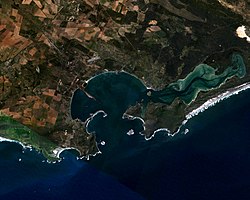Capitulation of Saldanha Bay
| Capitulation of Saldanha Bay | |||||||
|---|---|---|---|---|---|---|---|
| Part of French Revolutionary Wars | |||||||
 |
|||||||
|
|||||||
| Belligerents | |||||||
|
|
|
||||||
| Commanders and leaders | |||||||
| Vice-Admiral Sir George Elphinstone | Rear-Admiral Engelbertus Lucas | ||||||
| Strength | |||||||
| 13 ships | 9 ships | ||||||
| Casualties and losses | |||||||
| none | 9 ships surrendered | ||||||
The Capitulation of Saldanha Bay saw the surrender to the British Royal Navy of a Dutch expeditionary force sent to recapture the Dutch Cape Colony in 1796 during the French Revolutionary Wars. In 1794 the army of the French Republic overran the Dutch Republic which then became a French client state, the Batavian Republic. Concerned by the threat posed to the trade routes between Great Britain and British India by the Dutch Cape Colony in Southern Africa, a British expeditionary force had landed at Simon's Town in June 1795 and forced the surrender of the colony in a short campaign. The British commander, Vice-Admiral Sir George Elphinstone, then reinforced the garrison and stationed a naval squadron at the Cape to protect the British conquest.
The Batavian government immediately ordered an expeditionary force to sail to the Cape and recapture the colony. This force comprised two ships of the line and five smaller vessels, all under the command of Rear-Admiral Engelbertus Lucas. Security regarding the plans was weak and the British knew of the operation before Lucas had sailed. The British warned Elphinstone, who further reinforced the Cape. Lucas's journey took nearly six months, suffering shortages of drinking water leading to a near-mutinous state among his crews. On arrival, the Batavian fleet anchored in Saldanha Bay to take on fresh water before deciding to abandon the operation and sail to the French base at Île de France in the Western Indian Ocean.
...
Wikipedia
